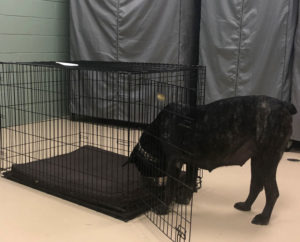
Setting boundaries builds strong relationships

Rather than forcing Mayflower into the crate when she resisted, I left the door open and put her food just inside. She can decide how far she wants to go for now, knowing that I trust her to make that decision. These small steps build a foundation of our relationship.
Things move fast in today’s workplace. And for good reason. Being nimble to adjust to changing landscapes is crucial. But there are some things that can’t be rushed, like the quality of strong work relationships. They are built with each interaction, either moving positively or negatively as we work on setting boundaries.
Getting to know each other is built on a series of interactions
It’s been more than a month since I first met our soon-to-be-foster dog, Mayflower. We have made progress; we are getting to know each other better. She will consistently let me take her on a walk alone, not needing the comfort of another familiar person. She’ll eat the treats I offer and isn’t stressed when we’re alone.
But not all is perfect yet. Some days the crate training goes better than others, and she almost always she wants to go back to her kennel area rather than stay with me longer.
Just like a manager and employee who are getting to know each other, there is an ebb and flow to the exchanges. In any working relationship, setting boundaries is important, including who has authority and how much autonomy exists for each person. Through trial and error, each person learns how far to push and when to relinquish.
Behaviors are indicators of the overall relationship — positive and negative!
These encounters cannot be rushed. We have to experience them to understand them. Your behaviors are indicators of whether the other person will learn to trust you, or worse, fear you.
As you begin to learn the other person’s tendencies, you can find small, practical ways to strengthen the relationship. For instance, Mayflower is most comfortable with me when we’re walking together. Being outside offers enjoyment and familiarity. She knows the terrain much better than I do. It’s there that I feel I can push a little when needed.
For example, I can redirect her if she’s going beyond the property lines, and she’ll allow me to do so. She relinquishes and turns to me and follows. However, when crate training inside, I don’t force anything. Going beyond her threshold is only teaching her that I don’t respect her wishes.
Instead, I want her to know that I’m willing to compromise when I can (such as not forcing her to go in her crate). But when I ask her to do simple things that I know she’s capable of (walking in a different direction), she and I can find ways to work alongside each other.
As you build trust with your team members, watch for signals that you can push (or that you’ve gone too far) and then continue setting boundaries with each other. For instance, perhaps offer more specific feedback on subjects that the person is most familiar with. Don’t drown someone in too much detail if they haven’t grasped key concepts yet.
Having too many negative exchanges will start to erode any good faith for the long term. Slow down and talk to the person, learn to understand if and how you have overstepped boundaries (from their perspective) and find a way to compromise.
Going back and forth will yield you a stronger relationship in the long run. You can’t bypass important steps to achieve what can only be realized with experiences that demonstrate respect for the other’s needs.

